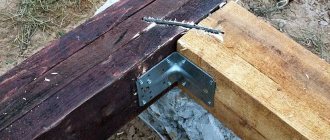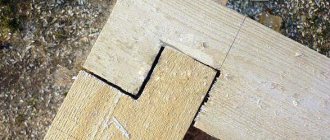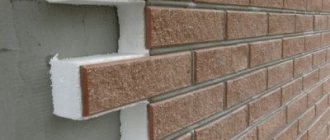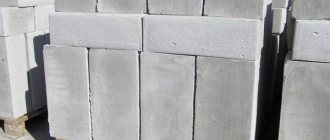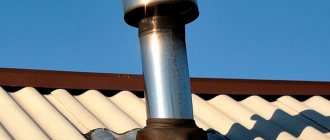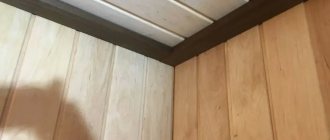In most cases, foam plastic is used to insulate private houses and industrial buildings. This material has excellent thermal insulation properties and a high level of environmental friendliness. In addition, it is resistant to bad weather conditions. Insulating a private home using polystyrene foam will cost 1.5-2 times less than insulating using other materials. Expanded polystyrene can be easily cut, drilled and glued.
Polystyrene foam is used to insulate private houses. It is a highly environmentally friendly material that remains resistant to temperature changes.
The material is made from polystyrene granules. It can be obtained by foaming with warm air. Polymer granules, which turn into thin capsules measuring 5-10 mm, are formed by extrusion into small blocks of the required thickness or designs in the form of various shapes. The ratio of polymer and air can be from 1:30 to 1:10. Thanks to this, it is possible to obtain materials of different densities.
The advantage of polystyrene foam is saving material consumption.
The advantages of polystyrene foam include the following:
- The material is chemical and moisture resistant.
- Does not swell in water.
- Not affected by mold and mildew.
- Durable.
- Resistant to temperature changes.
- Combusts only on contact with open flame.
Disadvantages of the material:
- Destroyed under the influence of carbon solvents.
- When ignited, produces a large amount of smoke.
- During combustion, it releases toxic substances.
Polystyrene foam, penoplex, expanded polystyrene - are they the same thing?
The name “foam plastic” combines foamed materials based on polymers. The raw materials can be polyurethane, polyvinyl chloride, phenol-formaldehyde and urea-formaldehyde plastics, as well as polystyrene. In everyday life, the polystyrene version (expanded polystyrene) is more common. This lightweight snow-white material is used for the manufacture of protective packaging, thermal insulation panels, disposable tableware, and elements of life jackets.
Another type of porous polymer is also made from polystyrene - extruded polystyrene foam. One of its trade names is penoplex. It has the same chemical composition as expanded polystyrene, but differs in production technology. To obtain it, the extrusion method is used - squeezing out a polystyrene mass foamed with a special agent.
Penoplex has the appearance of frozen foam of a yellowish tint. Penoplex blocks are used in construction to insulate walls, roofs and communications; model details and letters are cut out of them.
Application area
Polystyrene foam is used in various spheres of life. A large number of materials and products are made from it. The material also retains heat well, so it is often used to insulate walls.
Areas of application of expanded polystyrene:
- Construction works. In construction, it is used for thermal insulation of structures, houses, buildings, garages, hangars. It is also used for external insulation.
- In shipbuilding. Lifebelts, lifeboats, and light boats are made from it. Also used to fill the compartments of small boats.
- In medicine. In this area, foam containers are used to transport organs and medicines.
- In furniture production. It is added to the composition of the material from which various pieces of furniture are then made.
- For the production of packaging materials. Added to various bags, packaging, wrappers, and so on.
- For the production of outdoor advertising. It is added to advertising structures - banners, signs.
- In clothing production. It is added to many fabrics. Clothes containing foam are very warm.
Properties of foam plastic
Foamed polystyrene is a lightweight white polymer consisting of tightly compressed balls containing air. Polystyrene foam is very popular due to the following advantages:
- affordable price;
- ease of processing;
- non-toxic;
- inability to burn independently;
- waterproof;
- high thermal insulation potential;
- frost resistance;
- good sound insulation;
- resistance to fungus and other microbiological factors.
Styrofoam
How can you not glue foam plastic, what destroys it?
Not just any glue is suitable for gluing this type of polymer. Some of the commercially available and quite popular adhesive compositions contain components that react chemically with the foam. When they come into contact with the polymer, it partially dissolves, leading to deformation. What can not be used to glue this type of plastic?
List of substances unsuitable for working with foam:
- compositions containing acetone (usually they are used for preliminary degreasing of the seam area before gluing);
- petroleum derivatives (gasoline, kerosene, xylene and their analogues, as well as types of glue containing them);
- alcohols (may be present in glue, primer or degreasing fluid).
Consumption per 1m2
Calculation of consumption per sq. m. is needed to determine the required amount of material to purchase. It is impossible to calculate the exact amount. This is influenced by factors:
- material, its density and ability to absorb;
- consumption of a specific type and brand of mixture.
The average data is shown in the table.
| Type of composition | Consumption |
| Dry | 500 gr. / m² |
| Bituminous | 800-1000 gr. / m² |
| Polyurethane | 1 cylinder per 8-10 m² |
How can I glue foam?
There are several proven adhesive compositions suitable for gluing foam parts to each other or to other materials. The choice of adhesive depends on the type of foam, as well as the desired strength of the seam after gluing.
List of adhesives for foam plastic:
- one-component polyurethane adhesive (“Titanium”, “Dragon”);
- dry adhesive mixtures (“Ceresit-CT83”);
- polyurethane foam;
- liquid foam (“Penosil”);
- polyvinyl acetate glue (PVA);
- hot melt glue (a heating gun is required to work with it);
- solvent-free liquid nails for latex-based polymer materials (LN-604 or Macroflex MF 190);
- two-component epoxy compositions (“Ceresit”);
- acrylic compositions (“Ultima”);
- bitumen mixtures (“Bitumast”).
How to glue foam parts together?
In practice, several means are used to glue foam or penoplex parts together. They differ in seam strength, polymerization period, and cost.
PVA glue is suitable in cases where a high-strength seam is not required, for example, when making foam plastic models or for children's creativity. It is very important to wait until it dries completely, which occurs within 24 hours.
Titan glue is several times stronger, so it can be used in construction and installation work for fixing penoplex blocks to the wall or to each other.
How to glue the material to paper or wood?
Sometimes you need to glue foam letters to paper or a wooden stand. A composition based on polyvinyl acetate is best suited for this. It is ideally compatible with wood, paper and foam. PVA glue dries slowly, so letters or other glued parts should not be touched during the day. Also, foam glues well to wood using wood glue. One of its options, casein glue, can be prepared independently from low-fat cottage cheese, guided by the material “How to make casein glue from cottage cheese with your own hands at home?”
- sand the wood and foam in the area of future gluing for better adhesion;
- Clean the surfaces well from dust using a brush;
- apply glue around the perimeter of the part and in its center;
- combine the fragments and leave until completely dry;
- remove excess dried glue using a utility knife.
Bonding to metal
You can use expanded polystyrene to insulate a door or walls in a garage made of metal, as well as the inner surface of a roof made of corrugated sheets. Which fixation method is suitable for these purposes? Strong adhesion can be achieved using Dragon glue. This universal polymer glue costs about 70 rubles. for 500 ml. It is frost-resistant and does not contain flammable components. Before applying it, you should dry the surface thoroughly and make sure there is no condensation on it.
Foam blocks are smeared with glue and pressed against the metal for several minutes. This time is enough for the foam to stick to the metal, but complete stabilization of the adhesive composition occurs after about a day.
Basic rules for gluing and reinforcement to increase strength
Before gluing polystyrene foam and polystyrene foam, you need to understand some features:
- Polystyrene needs to be treated with a needle roller, this will increase the quality of gluing;
- You need to glue long fiber paper onto the foam.
To increase the strength and reliability of the gluing, you should create a paper frame on top of the foam products. Fiberglass is suitable for increased strength. Other options are gypsum or acrylic plaster. It all depends on financial capabilities.
How to prepare the surface
Before gluing any surfaces and products, they need to be treated to improve the quality of the final gluing. A well-chosen glue simplifies the procedure. You need to carefully apply the substance to the foam and combine it with the surface and press for several minutes. During this time, the surfaces will dry; you just have to wait until the glue dries completely.
The most important thing is to carefully and efficiently clean the surfaces from dirt and small dust particles. To do this, you can use a dry, clean rag or viscose rag. Pre-treatment will allow for high-quality gluing, the result will last a long time and reliably.
Wood surfaces are a slightly different story. Their surface is uneven and contains pores, needles and other deformations. In this case, the glue loses its adhesive properties and the quality of fixation will not be at a high level. Pre-treatment will not involve wiping the surface of the product with a rag, but sanding. Sandpaper and a plane will do. As a result, the surface will be smooth and uniform, the foam will not peel off immediately after fastening.
Useful tips
Several recommendations for choosing material and gluing technology:
- before purchasing, check the composition of the glue and make sure there are no components that destroy polystyrene;
- buy glue with a small reserve in case of possible overuse;
- pre-test the adhesive composition on an unnecessary piece of foam;
- for better adhesion, sand the surface of the polystyrene foam with sandpaper, walk over it with a needle roller or make notches;
- on large parts, glue should be applied around the perimeter and pointwise, in several places - along the inner surface;
- When gluing with polyurethane foam, leave the fragments under pressure until completely dry.
I hope the material presented is enough to glue foam in any situation. The next video is about how to use hot melt adhesive to join polystyrene foam.
Polystyrene foam is very durable - polystyrene retains its shape for at least 25 years when used outside and for at least half a century when used inside. You will probably be surprised, because many people talk about its fragility. Indeed, ultraviolet radiation and constant exposure to moisture can shorten the service life. But these same factors can shorten the life of almost any building material, including various types of insulation.
Expanded polystyrene is not afraid of mold and fungi - thanks to this, it can also be used in a humid environment, for example, in a basement. Polystyrene granules practically do not absorb moisture. However, they say that all kinds of rodents can easily make holes in polystyrene foam. Again, this is only partially true - if rodents have something to eat, they will make holes even in concrete. Deprive them of food or kill them with poison, and you won't have to think about their relationship with the foam.
Polystyrene foam does not support combustion - no matter what they say, but this material is many times safer than the same wood . In order for it to ignite, the temperature is twice as high as in the case of wood, and when burning it produces much less heat. The material is safe for human health and the environment - among the common myths there is also the myth that the material is allegedly harmful to human health. But dozens of studies have already refuted this myth a long time ago. Look around you, there is a huge amount of much more harmful materials around you.
One of the disadvantages of polystyrene foam is its low strength - it breaks easily, and even a small blow can leave a dent on its surface. For this reason, it must be protected from mechanical damage - traditionally, plaster mixtures are used for this. They also protect the material from exposure to ultraviolet radiation.
Walling
The presence on the market of various and very reliable adhesives contributes to the development of new technologies in construction. The construction of quickly assembled houses from aerated concrete blocks using glue allows you to reduce construction time and the cost of materials for preparing the solution.
The question of how to glue concrete to concrete does not pose any big problems. Manufacturers' offers of numerous adhesive compositions with excellent waterproofing properties allow you to make the right choice. The use of glue helps to avoid the appearance of “cold bridges”. And this saves homeowners heating costs by up to 30% in the future.
In order to answer the question of how to glue concrete to concrete, climatic conditions should be taken into account. According to their characteristics, adhesive mixtures can withstand fairly low temperatures, but some of them are used only for the construction of internal walls.
Another definite plus when using glue is the aesthetic appearance of the wall. After its construction from aerated blocks, no additional finishing is required, the seams are almost invisible.
Adhesives based on epoxy resins are not afraid of aggressive environments, exposure to moisture and other adverse conditions. When constructing production workshops with similar characteristics, the question of how to glue concrete to concrete can be resolved quickly.
Preparatory stage - what is important to do before gluing?
Polystyrene foam can be glued to almost any material. Gluing concrete, wood, plastic and polystyrene will take place without any special incidents - almost any glue or putty mixture will do. But with metal things are somewhat more complicated. It is attempts to glue these materials that lead builders to numerous mistakes.
The most common mistake is choosing an adhesive that contains acetone, gasoline or another solvent. Gluing foam boards using such adhesive bases leads to the destruction of the boards themselves. The second type of error is an insufficient amount of adhesive. It must be applied to the back side of the foam boards in at least five places - in the corners and in the middle. In order to save money, many builders apply glue at only three points, which is fundamentally wrong and violates the entire technology.
Preparing the surface for gluing
The next stage is preparing the base surface for work. It is known that foam boards can be glued to any flat surface: concrete, metal, wood, bricks. Only this surface must be carefully cleaned of dirt and old wallpaper, paint residues, whitewash, after which it should be primed with a special primer, which should penetrate deep into the ceiling. This procedure helps prevent fungal diseases and improves the adhesion of materials.
How to glue polystyrene foam to concrete and metal - methods for all budgets
First, let's look at methods that do not require large financial investments. The most budget option is PVA glue. Surely during the repair process it was repeatedly used as an additive to various plaster compositions - you should not purchase it specifically, use only the leftovers. The secret to using glue correctly is in a layer of burlap, which is impregnated with PVA, glued to the metal and then pressed onto the foam boards. The bond will be strong enough to withstand the upcoming layers of plaster.
However, if PVA is not at hand, and you will somehow go to the store, you can purchase another adhesive - polyurethane foam.
Yes, that’s it - in addition to its main use as a sealant and insulation, polyurethane foam has excellent adhesive qualities and is ideally suited for gluing foam in places where super-strong adhesion is not required. The foam comes in convenient cans, and you don’t need much of it. You just have to work very quickly, since the material hardens almost instantly. So if this is your first time faced with the need to glue foam to metal, this option will not be the most convenient for you.
Polyurethane glue is the most optimal way of gluing polystyrene foam boards to metal. It is also available in convenient cylinders, but to work with it you will need a mounting gun. For a single case, buy the cheapest tool; for regular work, take a closer look at quality products. If you choose this method, study the sequence of actions:
- Polyurethane adhesive can be applied to the surface of the foam in strips or dots. The distance between points is up to 7 cm.
- You should wait a few minutes - let the dots dry slightly.
- Gently press the plate against the metal surface.
- Support the foam board with a board or plywood.
- After 15–20 minutes you can remove the support.
Liquid nails - this method differs from the previous one in the speed of work. The fact is that the composition almost instantly attaches the plates to the metal. True, the adhesion strength is somewhat less than in the case of polyurethane glue. The combination of polyurethane glue and liquid nails is the best option for using adhesive materials.
Polyurethane adhesive provides adhesion strength, and liquid nails provide speed of work. And you can do without support! What else can you use to glue foam? If the amount of work is small and you have double-sided tape on hand, you can easily get by with this product. But in large areas the method becomes too expensive - it is cheaper to purchase polyurethane foam.
Types of adhesives
There are a lot of options for using polystyrene foam. All funds are divided into groups, each with its own characteristics.
Dry mixes
Available in powder form, which is diluted with water before use. The proportions must be indicated on the packaging. These are universal pastes that contain cement with other binding additives. Used for external and internal insulation work. Suitable for different surfaces, but most often they are chosen to glue foam to brick or concrete when insulating walls.
Powder mixtures have good strength. When properly diluted and applied, they will hold foam boards for 35-50 years. If you need adhesive for interior work, it is important to make sure that it does not contain toxic substances. For adhesives used externally, this is quite acceptable. Be sure to check the expiration date. For good mixtures it does not exceed a year from the date of release.
Liquid preparations
Gels and pastes in different forms of packaging. These can be bottles, aerosol cans, tubes for construction guns. The advantage of liquid formulations is that they are immediately ready for use. They do not need to be diluted at home, risking spoilage in case of an error in dosage. This group includes liquid nails and polyurethane-based mixtures. The latter are considered the best for gluing polystyrene foam.
They form a strong, durable connection. Polyurethane products are universal. They glue foam parts to any base and securely glue them together. It is very easy to work with such pastes. They are applied pointwise to the base, then pressed to the desired location. Polyurethane adhesives are available, used for facade and interior work, and their price is low.
Sometimes polyurethane foam is used as an adhesive. It holds the insulation well on concrete or brick and is used for attaching skirting boards to a base without finishing. The foam is easy to use, gives a strong connection, and is inexpensive. True, if the foam contains substances that dissolve styrene, it will not connect, but will only spoil the elements. This must be taken into account before using it.
Polystyrene foam, penoplex, expanded polystyrene - are they the same thing?
The name “foam plastic” combines foamed materials based on polymers. The raw materials can be polyurethane, polyvinyl chloride, phenol-formaldehyde and urea-formaldehyde plastics, as well as polystyrene. In everyday life, the polystyrene version (expanded polystyrene) is more common. This lightweight snow-white material is used for the manufacture of protective packaging, thermal insulation panels, disposable tableware, and elements of life jackets.
Another type of porous polymer is also made from polystyrene - extruded polystyrene foam. One of its trade names is penoplex. It has the same chemical composition as expanded polystyrene, but differs in production technology. To obtain it, the extrusion method is used - squeezing out a polystyrene mass foamed with a special agent.
Penoplex has the appearance of frozen foam of a yellowish tint. Penoplex blocks are used in construction to insulate walls, roofs and communications; model details and letters are cut out of them.
Required Tools
The set of tools and auxiliary materials required for gluing foam depends on the fixing agent used. In any case, you should prepare:
- polystyrene foam of the selected thickness, its quantity should be equal to the area that needs to be covered plus 10% for waste;
- a small spatula and a rag to remove excess adhesive mass; if they are not removed, hard lumps will form;
- a primer for treating the main surface to which the foam will be attached;
- wide primer brush;
- knife for cutting foam.
If you plan to additionally secure the slabs with dowels, then you need:
- hammer drill with 10 mm drill;
- hammer;
- special dowels shaped like umbrellas (fungi).
Installation of polystyrene foam on the balcony
When using a dry mixture, the following is additionally required:
- tap water;
- plastic mixing container;
- construction mixer (drill attachment);
- spatula-comb for applying the composition to the foam.
If aerosol glue is used, then a special mounting gun is required into which the can is inserted.
How can you not glue foam plastic, what destroys it?
Not just any glue is suitable for gluing this type of polymer. Some of the commercially available and quite popular adhesive compositions contain components that react chemically with the foam. When they come into contact with the polymer, it partially dissolves, leading to deformation. What can not be used to glue this type of plastic?
List of substances unsuitable for working with foam:
- compositions containing acetone (usually they are used for preliminary degreasing of the seam area before gluing);
- petroleum derivatives (gasoline, kerosene, xylene and their analogues, as well as types of glue containing them);
- alcohols (may be present in glue, primer or degreasing fluid).
How to choose glue
There is a fairly wide range of different adhesives for sale for working with polyethylene foam. And it is advisable to make the choice using the following criteria.
- The temperature range must match this characteristic of the insulation.
- Adhesive properties must be extremely high.
- If you plan to use glue for interior decoration, it must be certified and non-toxic.
- If adhesive is selected for exterior finishing, it must be resistant to a variety of weather conditions and temperature changes.
- If you intend to finish the sauna and bathhouse, then the glue will need to be mixed with water-repellent agents.
How can I glue foam?
There are several proven adhesive compositions suitable for gluing foam parts to each other or to other materials. The choice of adhesive depends on the type of foam, as well as the desired strength of the seam after gluing.
List of adhesives for foam plastic:
- one-component polyurethane adhesive (“Titanium”, “Dragon”);
- dry adhesive mixtures (“Ceresit-CT83”);
- polyurethane foam;
- liquid foam (“Penosil”);
- polyvinyl acetate glue (PVA);
- hot melt glue (a heating gun is required to work with it);
- solvent-free liquid nails for latex-based polymer materials (LN-604 or Macroflex MF 190);
- two-component epoxy compositions (“Ceresit”);
- acrylic compositions (“Ultima”);
- bitumen mixtures (“Bitumast”).
How to glue foam parts together?
In practice, several means are used to glue foam or penoplex parts together. They differ in seam strength, polymerization period, and cost.
PVA glue is suitable in cases where a high-strength seam is not required, for example, when making foam plastic models or for children's creativity. It is very important to wait until it dries completely, which occurs within 24 hours.
Titan glue is several times stronger, so it can be used in construction and installation work for fixing penoplex blocks to the wall or to each other.
How to glue the material to paper or wood?
Sometimes you need to glue foam letters to paper or a wooden stand. A composition based on polyvinyl acetate is best suited for this. It is ideally compatible with wood, paper and foam. PVA glue dries slowly, so letters or other glued parts should not be touched during the day. Also, foam glues well to wood using wood glue. One of its options, casein glue, can be prepared independently from low-fat cottage cheese, guided by the material “How to make casein glue from cottage cheese with your own hands at home?”
- sand the wood and foam in the area of future gluing for better adhesion;
- Clean the surfaces well from dust using a brush;
- apply glue around the perimeter of the part and in its center;
- combine the fragments and leave until completely dry;
- remove excess dried glue using a utility knife.
Bonding to metal
You can use expanded polystyrene to insulate a door or walls in a garage made of metal, as well as the inner surface of a roof made of corrugated sheets. Which fixation method is suitable for these purposes? Strong adhesion can be achieved using Dragon glue. This universal polymer glue costs about 70 rubles. for 500 ml. It is frost-resistant and does not contain flammable components. Before applying it, you should dry the surface thoroughly and make sure there is no condensation on it.
Foam blocks are smeared with glue and pressed against the metal for several minutes. This time is enough for the foam to stick to the metal, but complete stabilization of the adhesive composition occurs after about a day.
The gluing process will proceed faster if you use liquid nails. They set quickly, but the seam is less strong than when gluing with “Dragon”. This problem can be solved by using both adhesives at the same time. “Dragon” and liquid nails are applied pointwise to the insulation in different places. Due to the quick drying of liquid nails, the foam will quickly attach to the metal sheet, and it will not need to be fixed until the more durable “Dragon” has completely polymerized.
How to glue the fabric?
You can glue the fabric to the polystyrene foam or cover it with turns of twine or woolen thread using several compounds. PVA and hot melt adhesive are well suited for these purposes. Both materials, after drying, form a transparent and invisible seam. If immediate fixation is required, it is better to use hot glue. PVA takes longer to dry, about a day, but it allows you to achieve a stronger connection than hot glue.
Review of popular brands
The adhesive composition used for gluing polystyrene foam sheets to metal must be characterized by:
- endurance to decrease in temperature;
- possibility of use for outdoor work;
- absence of any solvents in the product;
- guaranteed high degree of adhesion of bonded surfaces;
- ease of use.
It is preferable to choose a composition that contains composite mixtures, bitumen or plasticizers.
"Ceresit"
Due to their high quality, the brand’s products are respected by professional builders. Advantages of the adhesive composition "Ceresit":
- Ideally applied to foam blocks;
- good ductility;
- can be used for interior and exterior work, resistant to temperature changes and various atmospheric phenomena;
- impact-resistant, vapor-permeable composition;
- environmentally friendly;
- long period of adjustment (20-25 min.).
Disadvantage: The working solution must be used within 2 hours.
"Moment"
The Moment glue line is expanding every year. Positive properties of the composition:
- even with prolonged use, the adhesive seam does not crack;
- has excellent technical characteristics;
- does not shrink or deform when dried;
- frost resistance, water resistance, heat resistance;
- the adhesive is available in containers of different volumes;
- short drying period.
The disadvantages include the unpleasant odor of the glue (disappears only after complete drying), and is more often subject to counterfeiting (as a result of which the composition contains toxic components that are harmful to health).
"Master Termol"
Combined adhesive for polystyrene foam “Master Termol” has the following properties:
- long period of adjustment of slabs (up to 50 minutes);
- high adhesion and ductility;
- the composition is environmentally friendly;
- the lowest temperature for using the mixture is -5 ˚С, which allows installation work to begin earlier and finish later;
- the technological movement time is 12 hours, after which the foam can be doweled.
Time to use the finished composition is 30 minutes, material consumption per 1 m2 is 6 kg.
"Profline 3K-45"
An adhesive mixture for installing foam plastic and mineral wool, which is suitable for interior and exterior decoration. Positive properties of the composition:
- ease of use;
- moisture resistance, elasticity, frost resistance;
- economy;
- high adhesion;
- Shelf life of the finished mixture is 2 hours;
- environmentally friendly product.
During preparation of the composition, preventive safety measures should be observed. The dry mixture is characterized by increased dust formation, so it is necessary to protect the eyes and respiratory tract from it.
"Penoplex Fastfix"
Highly effective composition for installation of thermal insulation. Advantages of glue:
- universal - glues foam equally well to various surfaces, including metal;
- ease of use - time for preparing the adhesive is reduced;
- heat resistance – not afraid of temperature differences from -50 to +90 ˚С;
- after the glue hardens, thermal conductivity is not impaired;
- no shrinkage.
Those who have used Penoplex Fastfix adhesive consider the disadvantages to be the fact that the amount of work performed to cover the surface does not correspond to what is mentioned on the packaging; it is much less.
Useful tips
Several recommendations for choosing material and gluing technology:
- before purchasing, check the composition of the glue and make sure there are no components that destroy polystyrene;
- buy glue with a small reserve in case of possible overuse;
- pre-test the adhesive composition on an unnecessary piece of foam;
- for better adhesion, sand the surface of the polystyrene foam with sandpaper, walk over it with a needle roller or make notches;
- on large parts, glue should be applied around the perimeter and pointwise, in several places - along the inner surface;
- When gluing with polyurethane foam, leave the fragments under pressure until completely dry.
I hope the material presented is enough to glue foam in any situation. The next video is about how to use hot melt adhesive to join polystyrene foam.
What is it for?
Gluing foam plastic includes several stages:
It is widely used in finishing facades, etc., again due to its lightness, hardness and resistance to moisture.
The material is glued together mainly when decoratively finishing the ceiling, when gluing together foam structures, etc. If we take, for example, finishing the ceiling, then polystyrene foam is one of the best materials, since it is hard, lightweight, durable, and It is also moisture resistant.
After this, place the surfaces to be glued to each other and press tightly. Depending on the type of glue, you have about a minute to change the position of the pieces, after which the substance will begin to set. To enhance adhesion, apply a thin layer of adhesive to the border of the two surfaces where they touch. For the next step, you will just need to wait for the glue to dry.
After selecting the adhesive, prepare the surfaces. It is necessary to clean them so that grease, dust and other contaminants do not reduce the tenacity of the glue. If you are working only with foam plastic, then it is enough to thoroughly wipe both sides with a dry cloth. When gluing foam to untreated wood or very uneven material, sand it with sandpaper. This is also necessary if you are dealing with large pieces of material. This will increase the level of adhesion and the foam will stick easily.
How to glue glass: detailed instructions

